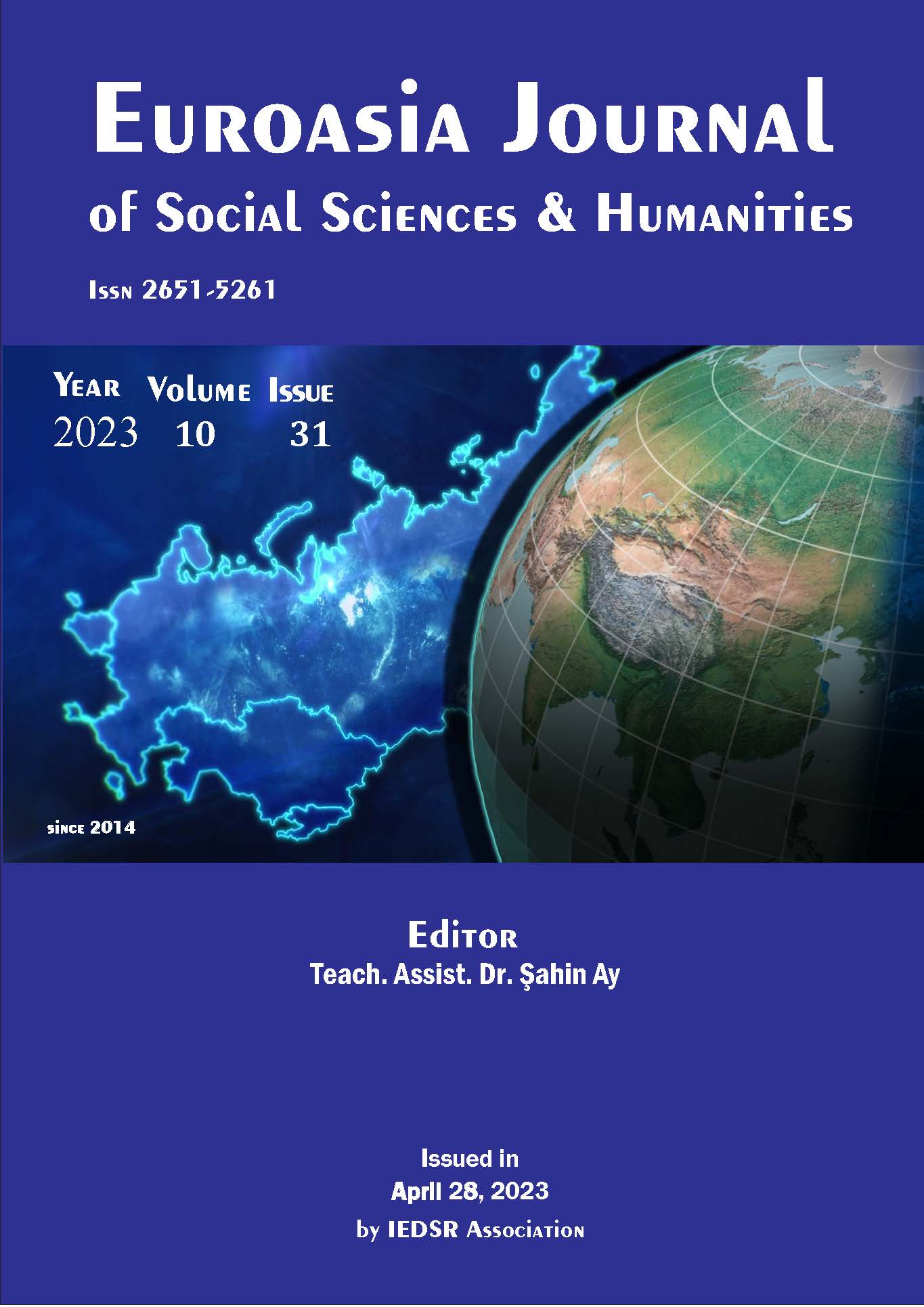Yabancı Dil Olarak İngilizce Öğrenen Hazırlık Öğrencilerinin Dil Öğreniminde Mobil Cihazların Kullanımına İlişkin Görüşleri
DOI:
https://doi.org/10.5281/zenodo.7942143Anahtar Kelimeler:
Mobil öğrenme, mobil cihazlar, internet tabanlı sözlükÖzet
Dil eğitiminde teknolojik cihazların kullanımı bir zorunluluktur çünkü dinleme ve konuşma becerilerini teknolojiden bağımsız olarak gerçekleştirmek neredeyse imkânsızdır. Bu çalışmada, Van Yüzüncü Yıl Üniversitesi 2021-2022 Eğitim-Öğretim yılında Yabancı Diller Yüksekokulunda öğrenim gören 25 öğrencinin Google Formlar ile hazırlanan ve beş adet açık uçlu soru içeren ankete verdikleri cevaplar MAXQDA 2020 programı ile analiz edilmiştir. Yapılan analiz sonucunda, hazırlık öğrencilerinin görüşleri doğrultusunda, mobil cihazların dil eğitiminde kullanılması dil eğitimini hızlandırır ve dolayısıyla zamandan tasarruf sağlar, öğrenilen bilgiler daha akılda kalıcı olur, bu cihazların önemli bir kaynak deposudur, öğrenmeyi eğlenceli hale getirirler, pratik yapmayı sağlarlar ve her yerde öğrenmeyi mümkün kılarlar sonuçlarına ulaşılmıştır. Ayrıca öğrencilerin sınıfta en çok Türkçeden İngilizceye ve İngilizceden Türkçeye olan Tureng sözlüğünü, ardından Cambridge ve Oxford sözlüklerinin uygulamalarını kullandıkları anlaşılmıştır. Öğrencilerin hiçbiri sınıfta kâğıt tabanlı sözlük kullanmamasına rağmen yaklaşık yarısının basılı sözlüğün çevrimiçi sözlükten daha avantajlı olduğunu belirtmesi bu çalışmanın şaşırtıcı bir sonucudur. Ayrıca öğrencilerin, sınıf dışında dil gelişimleri için ayırdıkları zamanlarının büyük bir bölümünü, sözlük uygulamalarında geçirdikleri, bunu YouTube, Cake ve Duolingo uygulamalarının takip ettiği tespit edilmiştir.
İndirmeler
Referanslar
Aamri, A., & Suleiman, K. (2011). The Use of Mobile Phones in Learning English Language By Sultan Qaboos University Students: Practices, Attitudes and Challenges, Canadian Journal on Scientific & Industrial Research, 2(3), 143-152.
Alemi, M., Sarab, M. R. A., & Lari, Z. (2012). Successful Learning of Academic Word List Via MALL: Mobile Assisted Language Learning, International Education Studies,5(6), 99-109.
Ally, M. (2013). Mobile Learning: From Research to Practice to Impact Education, Learning and Teaching in Higher Education: Gulf Perspectives, 1-10.
Başoğlu, E. B,. & Akdemir, O. (2010). A Comparison of Undergraduate Students' English Vocabulary Learning: Using Mobile Phones and Flash Cards, Turkish Online Journal of Educational Technology-TOJET, 9(3), 1-7.
Bohmer, M., Hecht, B., Schoning, J., Kruger, A., & Bauer, G. (2011). Falling Asleep with Angry Birds, Facebook and Kindle: A Large Scale Study on Mobile Application Usage, Proceedings of the 13th International Conference on Human Computer Interaction with Mobile Devices and Services. Stockholm, Sweden: Paper presented at MobileHCI 2011.
Bouca, M. (2012). Angry Birds, Uncommitted Players, Proceedings of DiGRA Nordic 2012 Conference: Local and Global - Games in Culture and Society. DiGRA.
Cheon, J., Sangno, L., Crooks, S.M., & Song, J. (2012). An Investigation of Mobile Learning Readiness in Higher Education Based on the Theory of Planned Behavior, Computers & Education, 59, 1054-1064.
Corbeil, J.E., & Corbeil, M.E. (2011). Are We Ready for Mobile Learning Now? 2007 Mobile Learning Predictions Revisited, Issues in Information Systems, XII (2), 142-¬‐152.
Darmı, R., & Albıon, P. (2014). A Review of Integrating Mobile Phones for Language Learning, Paper presented at the 10th International Conference Mobile learning.
Irina, A. (2012). A Cell Phone in the Classroom: A Friend or a Foe?, European Association for Computer-Assisted Language Learning (EUROCALL), 17-20.
Kukulska-Hulme, A. (2005). Mobile Usability and User Experience, Mobile Learning: A Handbook for Educators and Trainers, 45-56.
Kukulska-Hulme, A. & Shield, L. (2008). An Overview of Mobile Assisted Language Learning: from Content Delivery to Supported Collaboration and Interaction, ReCALL: Research in Computer-Assisted Language Learning, 20(3), 249–252.
Mahat, J., Ayub, A.F.M., & Wong, S.L. (2012). An Assessment of Students’ Mobile Self-Efficacy, Readiness and Personal Innovativeness towards Mobile Learning in Higher Education in Malaysia, Procedia Social and Behavioral Sciences, 64(9), 284-290.
Miangah, T. M., & Nezarat, A. (2012). Mobile-Assisted Language Learning, International Journal of Distributed and Parallel Systems, 3(1), 309.
Mohammed, T. A., Assam, B. N., & Saidi, M. (2020). The Use of Web 2.0 Tools in the Foreign Language Classroom, Journal of Educational and Social Research, 10(2), 177-177.
O'malley, J. M., Chamot, A. U., Stewner‐Manzanares, G. L. O. R. I. A., Russo, R. P., & Küpper, L. (1985). Learning Strategy Applications with Students of English as a Second Language, TESOL Quarterly, 19(3), 557-584.
Power, R. (2019) Design of Mobile Teaching and Learning in Higher Education: An Introduction, In Zhang, Y., & Cristol, D. (Eds), Handbook of Mobile Teaching and Learning (2nd ed., pp. 3-11). Singapore: Springer.
Saran, M., & Seferoğlu, G. (2010). Supporting Foreign Language Vocabulary Learning through Multimedia Messages via Mobile Phones, Hacettepe University Journal of Education, 38, 252-266.
Sharples, M. (2002) Disruptive Devices: Mobile Technology for Conversational Learning, International Journal of Continuing Engineering Education and Lifelong Learning, 12(5/6), 504-520.
Suwantarathip, O., & Orawiwatnakul, W. (2015). Using Mobile-Assisted Exercises to Support Students' Vocabulary Skill Development, Turkish Online Journal of Educational Technology-TOJET, 14(1), 163-171.
Thornton, P., & Houser, C. (2005). Using Mobile Phones in English Education in Japan, Journal of Computer Assisted Learning, 21(3), 217-228.
Traxler, J., & Kukulska-Hulme, A. (Eds.). (2007). Mobile Learning: A Handbook for Educators and Trainers, Routledge.
Trinder, J. (2007). Mobile technologies and systems, In Traxler, J., & Kukulska- Hulme, A. (Eds.), Mobile Learning: A Handbook for Educators and Trainers, (pp. 23-40). Routledge.
Turbill, J. (2015). Transformation of Traditional Face-to-Face Teaching to Mobile Teaching and Learning: Pedagogical Perspectives, Handbook of Mobile Teaching and Learning, (pp. 221-234), Springer.
Wang, Y. H., & Shih, S. K. H. (2015). Mobile-Assisted Language Learning: Effects on EFL Vocabulary Learning, International Journal of Mobile Communications, 13(4), 358.
İndir
Yayınlanmış
Nasıl Atıf Yapılır
Sayı
Bölüm
Lisans
Telif Hakkı (c) 2023 EUROASIA JOURNAL OF SOCIAL SCIENCES & HUMANITIES

Bu çalışma Creative Commons Attribution-NonCommercial 4.0 International License ile lisanslanmıştır.

